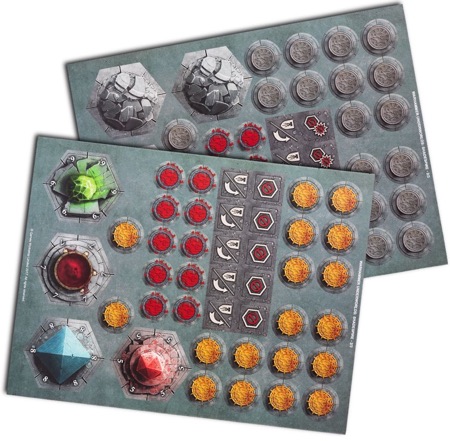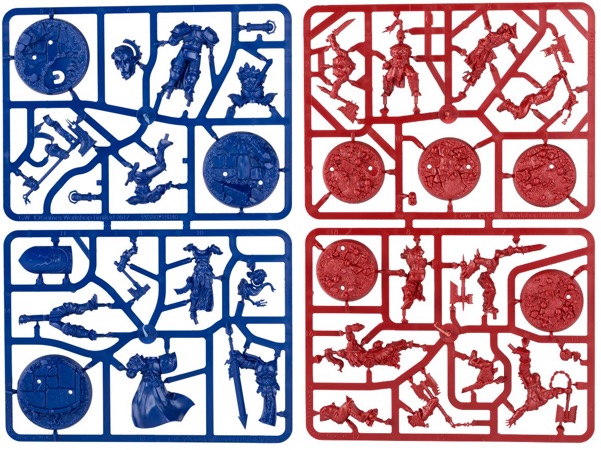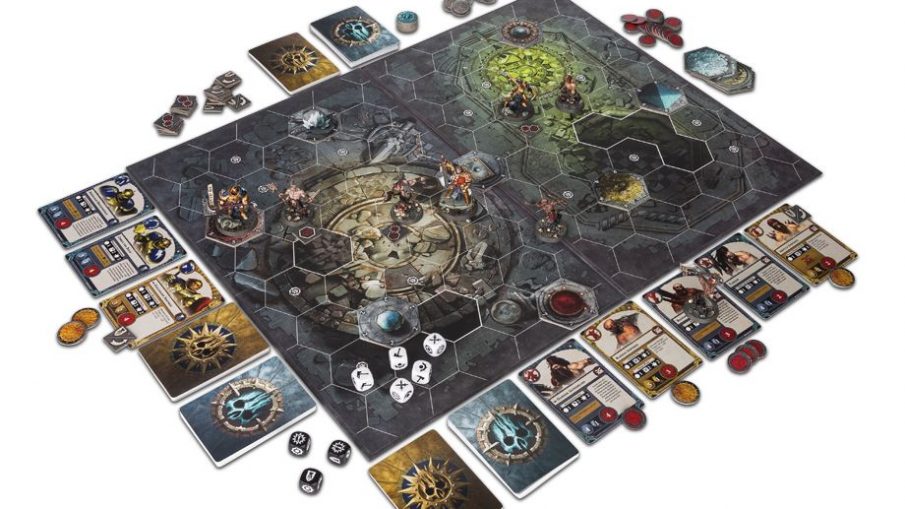Tabletop •
Games Workshop has been in the business of creating miniatures and games for more than 30 years. Earlier in their history, when this writer was much less grey, the company was known for creating a wide series of miniatures board games that served as entry points into their Warhammer 40,000 and Warhammer Fantasy universes. Some were great fun, while others were wild, crazy and unbalanced (and still a bit fun). Nevertheless, the company took efforts to attract gamers into their orbit and keep them there. GW underwent a change in focus for many years, purging almost all of those gems from their catalogue and putting their time and money solely into miniature games.
It seems there has been a change at Games Workshop, however, and they’ve been quietly releasing a series of miniatures board games for the last few years. Many of these were not priced to appeal to mainstream gamers, focusing on the GW fanbase instead. With their latest miniatures board game, Warhammer Underworlds: Shadespire, however, GW is taking a direct aim at competing with the mainstream products from their main competitors, Fantasy Flight and Cool Mini or Not.
Warhammer Underworlds: Shadespire is set in the Age of Sigmar fantasy universe. Player’s warbands are fighting in the shattered remains of the city of Shadespire, which has been destroyed and cursed by the Undead god Nagash. Players pick either the heavily armoured Stormcast Liberators, the lightning infused warriors of the god Sigmar, or the Bloodreavers who are combat mad followers of Khorne the god of war, blood, and skulls. Each warband has its own set of cards, objectives and play style.
The game includes eight plastic miniatures, two double-sided map boards, three sheets of counters, eight special dice, Quick Start rules, a 32 page rulebook and three sets of cards. The plastic miniatures are designed to be assembled without glue and, true to billing, they do fit together quite solidly and stand up to repeated play. The counters are printed on a heavy stock and are well cut and come out of the sheets easily. The map boards are beautifully illustrated and printed on matte stock. This is a welcome change from GW’s previous releases which were printed on a high gloss stock that reflected light in a manner that was only attractive to moths.

Every model in the game has an attractive card displaying movement, defence and wounds stats for the figure. In addition it shows attacks each model can use in combat and any special rules the figure has. Movement is the number of hexes on the map board that a figure can move, defence is the number of defence dice rolled when the model is attacked and the wounds are… well the number of wounds it can take. Attacks are defined by range, in hexes, attack dice and damage. Defence and attack stats also include a symbol that determines what results are needed on a dice to have a successful attack or to defend against one. Cards use icons for all of the model and attack stats which makes it easy to read the cards during play.
WU:S uses two different sets of dice–attack and defence–each with a slew of symbols: hammers, swords, critical hit, support, shields, dodge, and more. Attacks showing a hammer are more likely to hit while defenders who have shield icons on their defence stat are more likely to defend. Support icons reward players that bring more models to assist with an attack or to hold the line in defence. Coordinated attack and defence is one of the keys to the game.

Shadespire is played over three rounds each having four activations per player. Each activation can be used to move models, put them into a guard stance, attack, or draw more cards. After each activation there is a power step which is an opportunity for players to play plot cards or add upgrade cards to their models. Plot cards are temporary effects allowing models to gain more attack dice, protecting them from being pushed back, or giving the model or its attacks a special ability. Upgrades are permanently attached to a model providing stat boosts, new attacks, or special actions.

The final type of cards are objectives which gain Glory tokens which ultimately decide the winner of the game. Everyone starts with three objective cards which can be discarded and exchanged for new objectives at the end of each round. Objective are most often scored at the end of a round or the end of the game, but some grant immediate rewards based on actions such as taking out an enemy with a charge action or defeating the opposing warband’s leader.
The interplay between the plot cards, upgrades, and objectives adds a level of tactics and strategy you might not expect from a game with such a simple system. Players gain Glory through a number of different, hidden methods so your opponent is in the dark regarding your scoring objectives. Plot cards complicate the game, allowing for free actions, moving models, switching positions of models, or giving them new attacks with special abilities. Thinking you’re safe because an opposing model can’t move and isn’t close enough to attack only to watch it be upgraded with a lightning sword and zapping you from across the board is a delicious moment. Better yet is destroying one of your opponent’s models only to learn that its death earned them a Glory point.
Each game is over quickly, forcing you to vigorously prosecute your game plan and gain as many Glory tokens as possible. Simply killing the enemy won’t guarantee you a win and since the objectives are hidden it’s difficult to guess how your enemy is going to earn their Glory. This gives the game a breakneck pace and is often over before you realise it. The game is built to play with up to four, and objectives often change based on the player number.

Each of the two included warbands plays in a distinct fashion and have unique objectives. The Khorne warband gain Glory through combat and spilling blood. Anyone’s blood. The Stormcast Liberator’s objectives focus on protection, clearing the area of opposing models, and killing the enemy leader. Plot and upgrade cards provide interesting twists for each player but also make each warband fight in a particular fashion. The Khorne Bloodreavers throw themselves into combat and relish each combatant killed while the stalwart Stormcast Liberators try to cleanse the city and keep themselves safe and whole.
What is the most compelling about Shadespire is how the system works without an excess of rules or overabundance of additional cards. Shadespire seems streamlined compared to games like Imperial Assault and, while you have options as a player, you aren’t overwhelmed by the sheer abundance of them.
The components of the game are the usual GW quality. The art on the map boards, character cards and in the rulebook is exquisite. Some plot and objective card artwork is a bit bland, but considering that there are more than 60 distinct cards, this can be forgiven. Miniatures are up to Games Workshop’s usual top-notch standards and can be quickly assembled ready to play. I was rather indifferent about the game based on eaerly previews but getting it in my hands and playing it has made be a big fan.
Shadespire is something new for Games Workshop. It is a product that is clearly aimed at building a gaming experience akin to Star Wars X-Wing and also acting as a bridge for new gamers to come into the wider world of GW products. The game is priced very competitively (especially for a GW product) and Games Workshop has already announced expansions in the form of new warbands. Rules refer, many times, to multiple map boards so one can assume more of those are coming as well. The core game, as well as the planned expansions, also have cards that can be use in any warband so players will be able to customize their plots and objectives to match their play style or to try out new strategies.
Warhammer Underworlds: Shadespire redefines what a Games Workshop board game can be. It plays smooth, the art and miniatures are fantastic, and the game will appeal to more than just existing fans of GW products. This is probably GW’s best boardgame in decades and matches anything released by the current market heavyweights.



Great article!!!
I wanted to try it last saturday at local GW but I had an impediment, hopefully next week end.
Seems great and right up my alley…my son and me (both Silver Tower and general AoS skirmishes fanatics) are debating if/when to buy.
Loving the announced Sepulchral Knights expansion already (minis are fantastic) and I really like these no glue colored miniatures…let you open the box and almost immediately play.
Your article certainly didn’t make the wait any easier!!!
Glad you liked it. I am also eagerly awaiting the general release so I can get some more opponents Also looking forward to the two new Warbands.
Also looking forward to the two new Warbands.
I’m curious about why the minis need to be assembled at all? Is that a GW thing? When I buy a game from Cool Mini or Not, my miniatures are always assembled. Ditto Fantasy Flight, with the exception of the biggest minis. I’m not complaining, just curious.
The difference in quality is staggering tough.
To achieve the quality that only GW gives, you generally can’t use a single press so you have to assemble.
As Pitta said, the figures are a lot more detailed. A lot of gaming miniatures have figures with poses where nothing is across the chest or underneath other items in the miniature. One of the stormcast figures has a hammer that he holds across his chest and a second has a shield in front of her. For the detail of the chest and amour to be underneath those details they need to be separate pieces.
Some companies, like CMoN are producing multi-part models and then getting them assembled in China.
That said, this particular ones don’t require glue and are actually super easy to build…like 5 minutes.
It took me a full intense weekend to build all Silver Tower minis (not to mention almost a year to paint).
Even with my shit total newbie competence, they look orders of magnitude better than other brands minis.
I really hope GW will continue producing glue free minis.